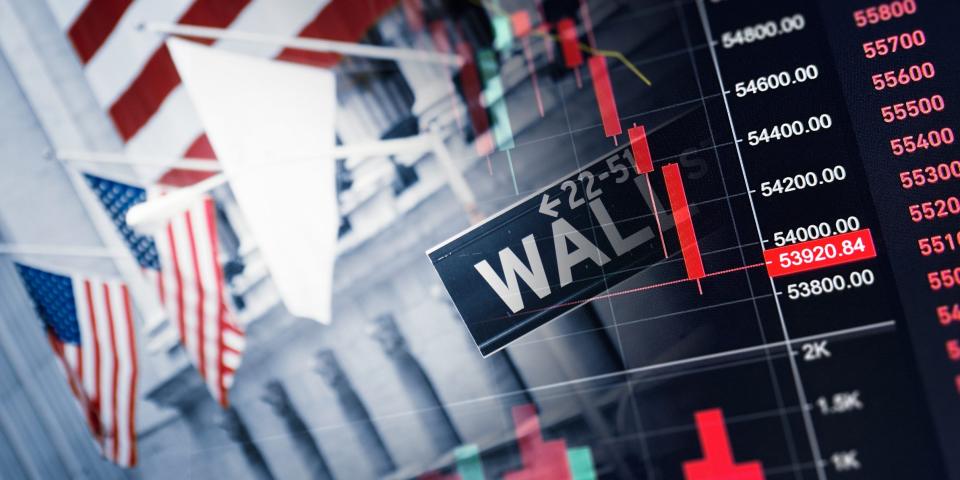Stocks could drop 30% over the next few years, according to Smead Capital portfolio manager Cole Smead.
That’s because the Fed risks cutting rates too early, causing inflation to spike and investors to flee the market.
Smead said that he saw a double-digit drop as the most likely scenario for stocks.
The Fed could end up making another big policy mistake this year — one that could end up sparking a double-digit plunge in the stock market.
That’s according to Cole Smead, the CEO and portfolio manager of Smead Capital Management. While other Wall Street strategists have raised their hopes for a soft-landing and immaculate disinflation, Smead thinks the Fed is on the cusp of making the same error it did in the 70s, when the central bank saw cooling inflation and prematurely began to slash interest rates.
That ended up being disastrous for the economy, plunging the US into a stagflationary spiral and, eventually, a recession. Stocks, meanwhile, were obliterated, with the Dow Jones Industrial Average seeing 45% of its value wiped out over the course of two years.
Today’s Fed looks poised to make that very same mistake — so much so that the current investing environment resembles 1972, Smead said. That was right before the stock market saw one of its worst crashes in history.
The most likely outcome? Inflation will roar back up and stocks drop 30% from their current levels over the next few years, Smead warned.
“It’s the worst-case scenario. I would also argue, I think it’s the most likely scenario,” he told Business Insider.
Fed rate cuts galore
That spells big trouble for the rest of Wall Street, where most strategists are expecting some, if not small upside for the S&P 500. Investors have been waiting for the Fed to lower interest rates in the economy and are ambitiously pricing in rate cuts. Six by the end of 2024, to be exact, according to the CME FedWatch tool.
That market-wide forecast could be tempered a bit after Fed Chair Jerome Powell was more hawkish than expected during remarks on Wednesday, after the Federal Open Market Committee held rates unchanged. He expressed caution around the central bank’s willingness to rush ahead with a rate cut at a time when inflation is “still too high” and the path forward is “uncertain.” Stocks tanked as a result.
But if the Fed does forge ahead with cuts as early as March, there’s a very real possibility it will do so at a time when inflation still hasn’t been fully tamed, Smead said, given that multiple price pressures still linger in the economy. The US debt, which is inherently inflationary, keeps climbing higher, with the total federal debt balance notching $34 trillion this year. Meanwhile, the labor market is still suffering from a shortage of workers, which has helped push wages higher and risks stoking inflation.
“Structurally, nothing has changed other than the supply chain has obviously got tighter and oil prices have come down,” Smead said, referring to supply disruptions from the pandemic, which temporarily stoked inflation and oil prices. “The other structural problems have not changed.”
That suggests the Fed runs a serious risk of cutting interest rates too early. And if inflation ends up coming back to life, that could spark a disaster in markets, causing investors to get spooked and rush to take their cash out of overpriced stocks.
Most at risk are the “Magnificent 7” stocks, Smead said, which have dominated most of the market’s gains last year.
Taking the 1970s parallel further, he points out that the “Nifty Fifty” — a group of large companies that dominated in the market during the first half of that decade — ended up crashing in 1973 and 1974, with stocks like Disney and Coca-Cola wiping out more than 50% peak-to-trough.
Smead sees a 50-50 chance that stocks will follow that same playbook, with the overall market losing around 30% of its value over the next two years as inflation spikes. In another scenario, he sees a 25% chance that stocks will do poorly without a spike in inflation.
That leaves just a 1-in-4 chance stocks will continue to do well in the next few years, Smead warned. In that scenario, inflation will remain low, though the US economy will be in a full-fledged recession.
“That part of the rhyme I think looks very miserable,” Smead said of the parallels to the 70s. “Our next trouble [could be] waking up in a world where inflation picks up and stock returns are nose diving,” he added. “That’s a probable path.”
Fears of a coming stock-market correction have grown in recent weeks as investors eye an uncertain economic backdrop and the looming risk of recession. As of December, more than 60% of investors see more than a 10% chance of a 1987-style stock market crash happening in the next six months, according to Yale’s US Crash Confidence Index.
Investors are particularly concerned for the Magnificent Seven, as tech giants like Tesla look overvalued. In a previous research note, Smead Capital warned investors of the risk of a stock market failure, an event that could wipe out the most expensive stocks on the market as much as 70%.
Read the original article on Business Insider
Credit: Source link




